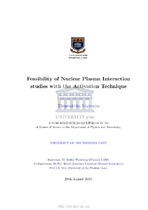| dc.description.abstract | Electron-mediated nuclear plasma interactions (NPIs), such as Nuclear Excitation
by Electron Capture (NEEC) or Transition (NEET), can have a signi cant impact
on nuclear cross sections in High Energy Density Plasmas (HEDPs). HEDP
environments are found in nuclear weapons tests, National Ignition Facility (NIF)
shots and in the cosmos where nucleosynthesis takes place. This thesis explores
the impact of NPIs on highly excited nuclei. This impact is understood to be more
intense in highly-excited nuclei states in the quasi-contiuum which is populated
by nuclear reactions prior to their decay by spontaneous
-ray emission. Attempts
thus far have failed in measuring the NEEC process, while NEET process
has been observed experimentally. Direct observation of NPIs is hindered
by the lack of a clear signature of their e ect in HEDP environments. Hence this
should test a new signature for NPIs for highly-excited nuclei by investigating
isomeric to ground state feeding from the isomeric state. An experiment was performed
using the reactions 197Au(13C, 12C)198Au and 197Au(13C, 12C2n)196Au at
Lawrence Berkeley National Laboratory in inverse kinematics with an 197Au beam
of 8.5 MeV/u energy. Several measurements were performed with di erent target
con gurations. The activated foils were counted at the low-background counting
facility of Lawrence Livermore National Laboratory. From these data, the double
isomeric to ground state ratio (DIGS) were extracted with the assistance of the
decay equations that were included in the experiment. As the NPIs e ects are
rather small the lines for analysis had to be chosen carefully so that the extracted
ratios would not contain signi cant errors. The measured DIGS ratios were then
compared with the result of the theoretical DIGS ratios. The results showed that
the calculated DIGS ratios deviated substantially from unity although this was
with large uncertainties. Because of the large errors obtained, the DIGS ratios
were found to be inconclusive as a signature for detecting the e ects of NPIs such
as angular momentum distribution changes in HEDP environments. | en_US |

